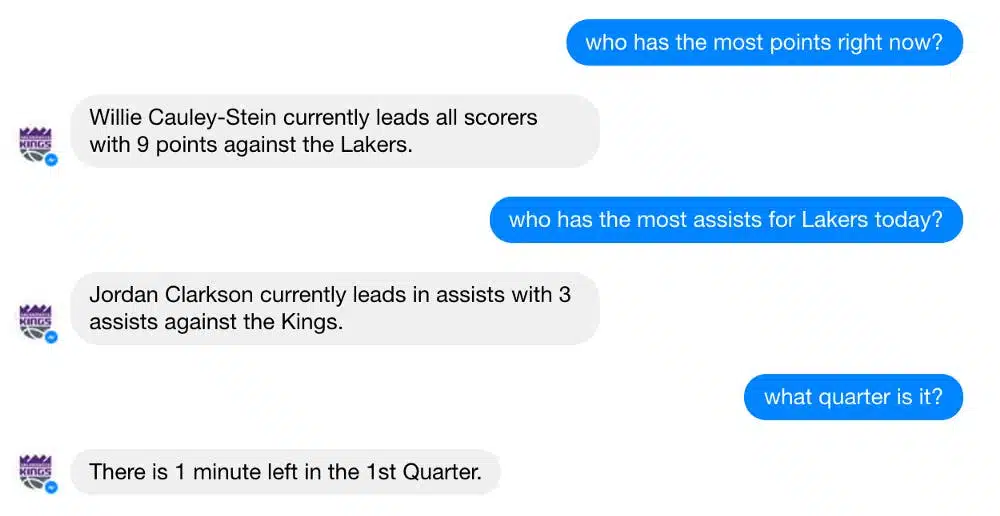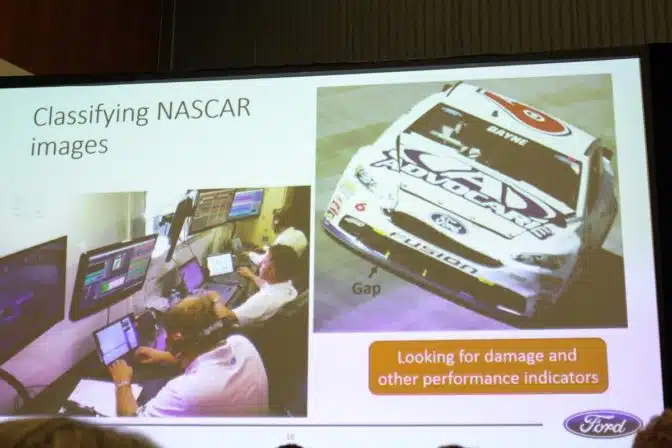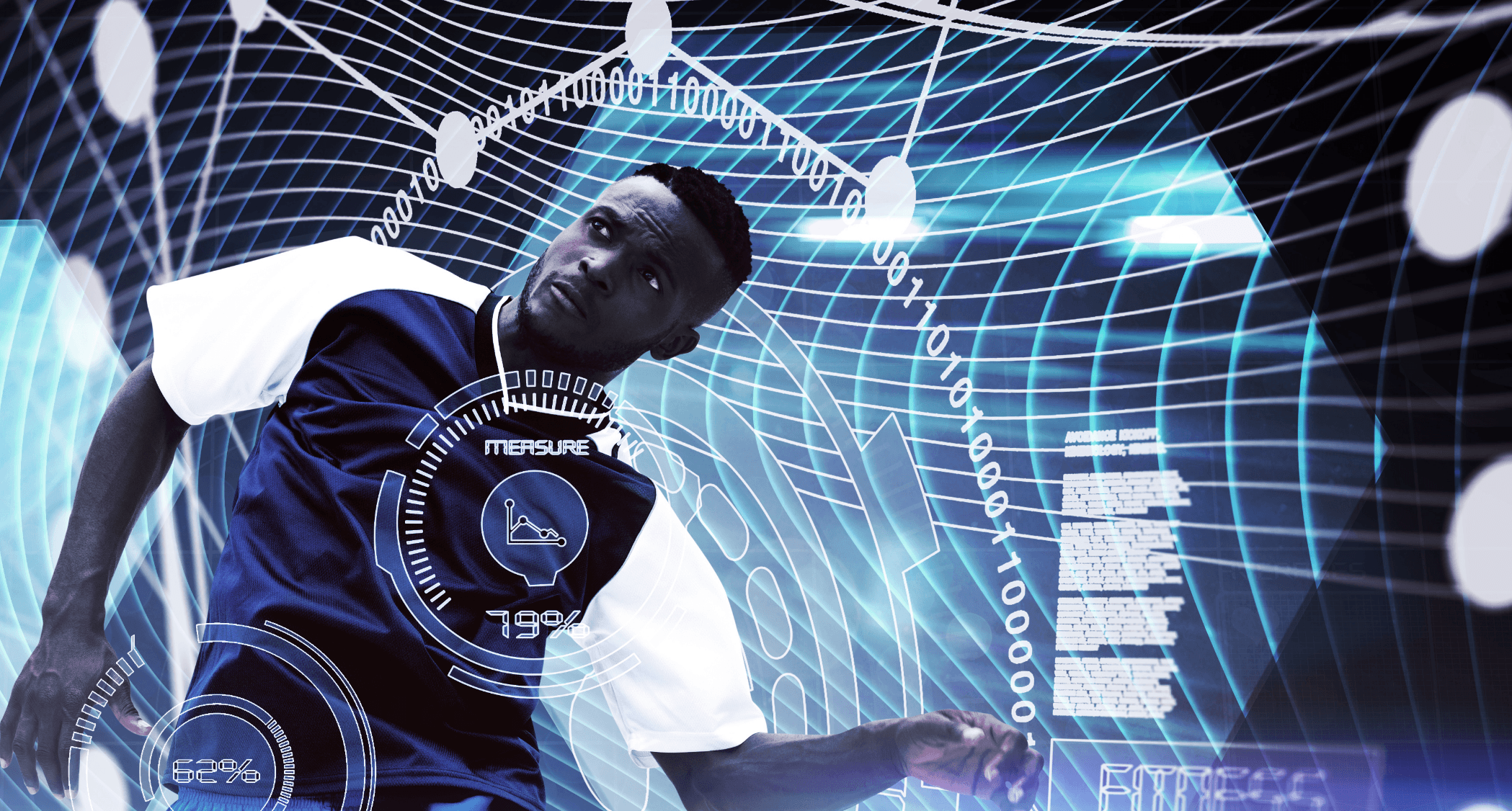The North American sports industry is a cultural and economic staple generating billions of dollars in revenue each year. Spectator sports fall under the broader category of arts, entertainment, and recreation, representing 1.1 percent of the GDP in 2016. Artificial intelligence in sports may have been rare just five years ago – but now AI and machine vision are making their way into a number of sports industry applications, from chatbots to computer vision and beyond.
We set out in this article to examine the applications of artificial intelligence in professional sports to help business leaders understand current and emerging trends within the industry.
In this article we will explore the following sub-topics in order:
- Summarized insights from our research on AI in sport
- Current applications of artificial intelligence in professional sports
- Potential future applications of artificial intelligence in professional sports
Before exploring the present applications, we’ll begin with background facts and a quick summary of the findings of our research on artificial intelligence in professional sports.
Artificial Intelligence in Sports – Background Info and Insights Up Front
The North American sports industry is projected to reach $73.5 billion in revenue by 2019. Revenue can be divided into four main segments:
- Gate revenues: Primary ticket sales from sporting events.
- Media rights: Fees paid by the media to broadcast sports on networks/stations.
- Sponsorship: Fees paid to have a brand associated with a team, league, facility or event, including naming and category rights.
- Merchandising: The sale of licensed products with team and league logos, player likenesses, and other intellectual property.
Since 2010, gate revenues have remained the leading revenue segment. However, according to a PwC research report, media rights are projected to become the leading segment of revenue beginning in 2018.
Media outlets are increasingly focused on enhancing the spectator experience through technology and AI is helping to shape the look and feel of the sports enthusiasts’ experience.
Current applications of AI appear to fall into four major categories:
- Chatbots – Sports teams are using virtual assistants to respond to fan inquiries across a wide range of topics including live game information, team stats and arena logistics.
- Computer Vision (as it pertains to professional auto racing) – Researchers are training deep learning neural networks to achieve accuracy beyond humans in the ability to identify specific cars at high speeds which typically produce photographic images with reduced clarity.
- Automated journalism – Media outlets are leveraging AI-driven automation to expand their sports coverage capabilities and increase revenue.
- Wearable tech – Companies are using AI in conjunction with IoT devices to gather data to attempt to optimize training and performance.
Next, we’ll explore the major areas of current AI applications in professional sports:
AI Applications in Across Major Sports
1 – Chatbots for Sports / Sports Teams
NBA
In June 2016, in partnership with Sapien, a custom bot developer (formerly known as JiffyBots), the Sacramento Kings introduced a chatbot called KAI – an acronym for Kings Artificial Intelligence.
The chatbot operates through the Facebook Messenger platform for the purpose of answering fan inquiries including info about franchise history, current team stats, the team roster, franchise history and details about the Golden 1 Center, the home arena of the Sacramento Kings.
While the franchise is keeping details on the number of users and their strategic goals for the chatbot under wraps for now, Kings CTO Ryan Montoya has stated his “commitment to utilizing technology to enhance the fan experience.” In fact, the franchise claims that the Golden 1 Center is the “world’s most technologically advanced and sustainable arena.”

According to a 2016 report published by communications firm Avaya,“a digitally connected fan is becoming a [sports] venue’s biggest online influencer.”
“Stadium owners and teams that provide more personalized digital experiences through stadium apps, digital offers direct to mobile phones, and game information on digital boards can increase fan engagement and generate new revenue opportunities.” – Connected Sports Fans 2016 report by Avaya
Hailing from Silicon Valley, team owner Vivek Ranadive is shaping the vision for the Kings and it appears that technology is a priority:
“The mission is to build a winning franchise…And so we have to win, and we have to win a championship. And that’s the goal; that’s a given. But the fans here are pretty amazing; they’re actually heavy consumers of technology. It’s a young fan base; we have 160,000 young people in this area. And they have a voracious appetite for technology and for new things. And so I think the fans are ahead of us. I don’t think we are ahead of the fans.” -Vivek Ranadive, 2015 interview with the Sacramento Bee.
NHL
The NHL is also incorporating AI into its customer engagement framework. In April 2017, Tampa Bay Lightning partnered with Satisfi Labs, a company that designs virtual assistants, to bring its chatbot to ice hockey enthusiasts. “Thunder Bot” can respond to fans’ questions regarding various topics including specifics about Amalie arena (Tampa Bay Lightning’s home arena), tickets to games and general parking information for game day. Human customer service representatives will be able to intervene if the bot is unable to provide a satisfactory response to an inquiry.
Thunder Bot is designed for functionality across multiple Tampa Bay Lightning platforms including the team’s official website, the Tampa Bay Lightning text club (text alerts) and NHL and Amalie Arena apps. While a specific date has not been specified the ice hockey franchise also plans to integrate its virtual assistant into the Facebook Messenger platform.
The Lightning’s VP of Marketing, Eric Blankenship, has stated that the Thunder Bot “will make it much easier and convenient for our fans to attend games” and keep up with team. However, when Thunder Bot was announced to the public, the franchise did not disclose any data to show specifically how the bot will improve customer service.
In a published case study, Satisfi Labs describes how it worked with an unnamed “leading sports entertainment franchise” to boost awareness and revenue of premium offerings to ticket buyers through a “native client app.” The company claims that over 50 percent of individuals who saw the Satisfi feature actually used it. Satisfi Labs estimates that projected annual revenue was roughly $25,000.
2 – Computer Vision Applications in Sport
NASCAR
Safety continues to be a primary focus for NASCAR, the sport has averaged more than one death annually since 1950 and shows a continued trend in the past five years. Fatal crashes are both tragic and costly. A single race car is estimated at $300,000 (not including repair, maintenance or labor costs) and tires are changed every race with a reported price tag of $500 per tire.
Argo AI/Ford Motor Company has used deep learning to develop self-driving cars and is now expanding its application of deep learning to help improve safety measures in the world of auto racing.
Specifically, the design team recognized that its deep learning neural network was capable of identifying specific cars using images. The design team originally used a dataset containing thousands of images to train the neural network. It is unclear as to how much better the network performed but the team claims it was particularly evident in the case of blurry images. The reduced visibility is due to high speeds at which the cars are moving.
As the network gained proficiency, it reportedly provided more accurate results than humans in its ability to identify specific race cars. The ability to quickly identify and access a car that is experiencing a malfunction during a race is significant; small malfunctions can quickly lead to more serious problems such as fires, putting the driver in danger.


Ford has made a $1 billion investment in Pittsburgh-based Argo AI over the next five years as the company aims toward bringing its first autonomous vehicle to market in 2021. The International Speedway Corporation (ISC), NASCAR’s parent corporation, reported $661 million in revenue in 2016.
(Readers with a direct interest in computer vision applications may be interested in listening to our full interviews with computer vision experts Igal Raichelgauz and Nathan Hurst.)
3 – Automated Sports Journalism
Minor League Baseball (MiLB)
AI is ushering in a new era of sports journalism through automation. The Associated Press is working with Automated Insights, a North Carolina-based startup to expand the media outlet’s coverage of games in Minor League Baseball.
Wordsmith, developed by Automated Insights, is AI-driven platform that translates hard data from MiLB into narratives, using natural language. As a result, AP has increased its reporting capacity to cover 13 leagues and 142 MLB-affiliated teams. Automated Insights claims that this translates to “3,700 quarterly earnings stories – a 12-fold increase over [AP’s] manual efforts.”
AP is one of 200 clients using the Wordsmith platform which generates a reported 1.5 billion pieces of content annually. To date, Automated Insights has reportedly raised $10.8 million in Series A and Series B funding from 10 investors which includes a mix of startup partners, venture capitalists and investment firms.
Sports works well for automated journalism since sports stats are numbers-based. These data can be structured in a way which makes automated articles easy to write. Emerj has conducted research on automated journalism, exploring the breadth current applications across industries.
4 – Wearable AI Tech
Boxing
PIQ, a French sports robotics startup and Everlast joined forces to develop what is described as the “first AI-powered wearable for combat sports.” Crafted using GAIA Intelligence, (machine learning platform for sports analytics) the startup claims that the platform is capable of tracking and analyzing “microscopic variations in boxing movements” to help maximize the efficiency of workouts and training.
The data that are recorded can also be accessed through a phone app which allows users to track their activity and see how they compare to other users based on a leaderboard.
To date, PIQ has reportedly raised $5.5 million in Series A funding from 3 investors. Time will tell if this promising collaboration will make a sustainable impact on the sport of boxing.
Connected Sneakers
India-based Boltt Sports Technologies is looking to disrupt the international market with its brand of AI-powered wearable products. The company is attempting an interconnected approach to its offerings which include “connected sneakers,” fitness trackers and a “stride sensor.”
The connected sneakers are designed with a stride sensor which can be synced via bluetooth with the company’s app. Using machine learning, the app tracks performance data and then provides recommendations based on user goals. Other app features include a nutrition guide, workout library and custom training programs.
“We’re trying to displace the need for a nutritionist, a doctor, and an activity center.” “We think that this is the next thing for the future of wearables, where you need to go beyond just tracking.” – Aayushi Kishore, co-founder, Boltt Sports Technologies (Sports Illustrated, January 2017)
Prior to launching Boltt, in 2011 co-founder and CMO, Aayushi Kishore established a shoe brand in India called Globalite. Estimated annual revenues for Globalite which became a competitor of international shoe brands (such as Nike and Adidas) totaled $7.5 million USD (500 million rupees). To date, Boltt has reportedly raised $600,000 in total equity funding in its quest to become an internationally competitive brand.
Potential Future Applications
Next, we will explore some potential future applications of AI in professional sports. It is important to note that is not an exhaustive list. We aimed to provide a high-level view of major applications that emerging from the sports industry, giving readers a sense of technologies that either (a) may become mainstream, or (b) are indicative of an important future trend.
1 – AI Assistant Coaches
NFL
Using AI to help NFL teams develop and/or improve game strategies may not be too far in the distant future. Oregon State University researcher Alan Fern is using videos of games and deep learning to train computers how to understand the game of football and coach plays.
Effective coaching is a skill that requires experience and is developed overtime; it is also an imperfect science. Computers could possibly provide coaches and teams with improved accuracy in analyzing common mistakes and improving plays at a faster rate than humans.
“For example, knowing how players move during a game could help coaches plan an athlete’s training so he reaches peak performance. It could also shed light on the best matchups between receivers and cornerbacks and measure the contribution of each player to every play.” – Alan Fern, a computer science professor at Oregon State University
While the ROI on developing virtual assistant coaches may not be readily apparent, the focus is on using deep learning to uncover strategic insights that may not have been previously achievable.
2 – Smart Ticketing
NLS
The San Francisco Deltas, a new soccer team that debuted in 2017, aspires to use AI to build and increase fan engagement. Among the team’s interest is smart ticketing, a technology that allows ticket buyers to change seats, from game to game, based on their backgrounds and interests.
For example, a fan could sit with their family during one match and move to a section with a “louder, more energetic supporters’ section.” This option follows a industry-wide trend of enhancing sports fan’s experience with their favorite teams.
3 – Automated Video Highlights
Tennis
IBM announced plans to enhance the Wimbledon experience using cognitive computing capabilities through the Watson platform beginning in 2017. Examples, include AI-automated video highlights. CNBC put together a video explaining how IBM’s system picked up “key moments” in the match by drawing data from players, fans, and more:
IBM claims its technology will support a team of research scientists and consultants, to automatically curate game highlights based on game-specific data such as “analysis of crowd noise, player’s’ movements and match data.”
The process of organizing and processing video highlights can normally take hours and IBM aims to significantly accelerate the process. It is not clear from the company’s announcement, how much faster they expect their platform to perform this procedure.
4 – Computer Vision Referee
Tennis
Bay Area-based French inventor Grégoire Gentil has designed a $199 pocket-size device that called “Tennis In/Out”, which uses computer vision to detect the speed and placement of a tennis shot – including whether the ball was out of bounds:
While the device is currently a novelty application, it demonstrates the increasing accessibility of AI software and camera hardware. Hobbyist AI applications are today still rather novel, but it’s unlikely to remain rare as open source AI tools and online education courses flourish. Combinations of IoT and AI are becoming more popular, and we presume that sports (and broadly: Health) will be an industry ripe for innovation of this kind.
Concluding Thoughts on AI in the Sports Industry
AI is impacting nearly every major professional sport. This is a timely disruption of the industry as media involvement becomes increasingly important as the leading source of revenue in professional sports.
It is clear from the direction of this trend that fans are demanding more access to their favorite sports team and technology is a necessary conduit to meeting this demand. AI is providing customized frameworks for fans to feel closer than ever to the players and the game.
More personalized experiences and more helpful automated interactions may well mean more fan loyalty and engagement over time. In this respect, artificial intelligence in sport won’t be much different than its applications in media and software generally.
Wearable tech is another application of AI in sports that holds great promise for future growth. Companies are realizing the need to go beyond just tracking data to converting it to meaningful insights that actually help athletes meet their performance goals. These products can also appeal to fitness enthusiasts as well as professional athletes, offering wide market reach.
The NCAA estimates that nearly 8 million individuals currently participate in high school athletics. On the professional front, the U.S. Olympic Committee’s director of technology and innovation, Mounir Zok, has stated that wearable tech contributed to Team USA earning 121 medals at the 2016 summer Olympic Games.
Wearable tech could easily move from a competitive advantage to a standard component of athletic training in the coming years. As in the world of heavy industry and manufacturing (where we covered recently), smart companies may be able to gain a continual edge over the competition by gaining more and more granular data on their equipment – in this case – the athletes themselves.
It’s important to note that most of the applications of AI in sport are still in a “test” or “pilot” phase, and it may be another three or four years before stadium chatbots and IoT wearables become commonplace and clearly advantageous. They may cost more than they return for the time being, but companies making the investment are hoping to stay ahead of the pack as the innovations deliver returns.
We will continue to monitor how the industry evolves as we anticipate steady implementation of AI overtime.
Header image credit: 3D Insider – Optitex




















